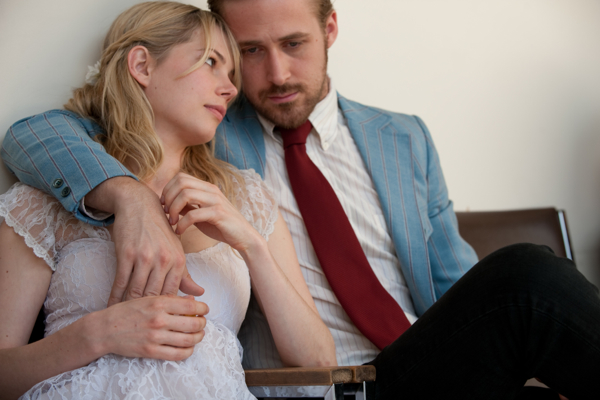Movie review by Greg Carlson
Relying on a fluid editing structure that contrasts past and present, director Derek Cianfrance’s labor of love “Blue Valentine” is a painful domestic drama anchored by Ryan Gosling and Michelle Williams, the skillful performers playing a couple on the brink of divorce. Both stars double as executive producers, and Williams reportedly received a version of the script when she was only 21. Cianfrance intended to shoot the early relationship sequences and then wait several years to complete the material that takes place when the characters are older, but budget limitations prevented any prolonged or interrupted shooting schedule.
The minor press drama surrounding the almost NC-17 rating of the movie proves more interesting than the film itself, a metaphorically bloody dissection of the doomed relationship of Gosling’s Dean and Williams’s Cindy. While Harvey Weinstein’s personal appeal to the MPAA spared the film any cuts (the original objection centered on a short scene of discreet cunnilingus), the film’s one-sheet is the sexiest thing about “Blue Valentine.” The intercourse that materializes onscreen, especially a near coupling in a space-age themed novelty hotel room, is caustic – even humiliating – and laced with a purposeful artlessness that highlights love’s extinction.
Whenever Cianfrance cuts to the scenes of Dean and Cindy’s courtship, the audience breathes a small sigh of relief. As the “now” scenes crushingly hammer toward demolition, the “then” scenes fill in the relationship’s construction. Dean’s sensitivity places a somewhat dubious halo around Gosling that the actor struggles to shatter. Dean supports Cindy all the way, from a literal last minute change of heart over an abortion to a steadfast commitment to raise daughter Frankie as his own. He deals with Cindy’s less than supportive family and survives that tried and true movie trope: a vicious beatdown from Cindy’s awful ex.
Karina Longworth aptly and accurately pointed out that “Blue Valentine” favors Dean’s point-of-view over Cindy’s, and that the film as made demonstrates a “lack of interest in imbuing [Cianfrance’s] female character with the rich interior life and complicated morality he gives his male lead.” While Longworth wonders aloud about the possibility of misogyny, viewers will find themselves longing for any opportunity to understand Cindy as something other than burned out, exhausted, and constantly prepared to reject any and all of her husband’s attempts at reconciliation and affection. The unfortunate result casts Cindy as a cruel shrew and aligns the movie with Dean’s desperate desire to hold the marriage together and protect Frankie from growing up in a broken home.
“Blue Valentine” unapologetically embraces the gut-wrenching death throes of a once promising union through the minutiae of observed details and improvisational performances, a bold directorial decision that is certain to turn off more viewers than it attracts. Designed to showcase every inch of working class drabness, the film benefits substantially from Grizzly Bear’s atmospheric music as well as the nearly forgotten early 1970s demo “You and Me,” credited to Penny and the Quarters (an interesting story in itself). The obscurity of the song, which Cianfrance shared with Gosling but deliberately kept from Williams, symbolizes the dedication of the filmmakers to their constructed universe, even though that world teeters on the precipice of oblivion.
